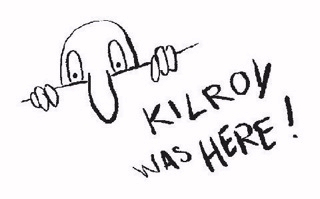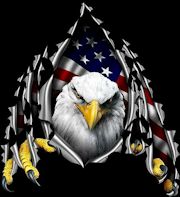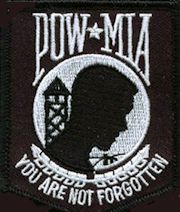For the WWII generation, this will bring back memories. For you younger folks, it’s a bit of trivia that is a part of our American history. Anyone born in the teens, twenties, and mid-thirties, is familiar with Kilroy. We didn’t know why, but we had lapel pins with his nose hanging over the label and the top of his face above his nose with his hands hanging over the label. No one knew why he was so well known, but we all joined in!
So who the heck was Kilroy?
In 1946 the American Transit Association, through its radio program, “Speak to America ,” sponsored a nationwide contest to find the real Kilroy, offering a prize of a real trolley car to the person who could prove himself to be the genuine article. Almost 40 men stepped forward to make that claim, but only James Kilroy from Halifax, Massachusetts, had evidence of his identity.
Kilroy was a 46-year old shipyard worker during the war who worked as a checker at the Fore River Shipyard in Quincy. His job was to go around and check on the number of rivets completed. Riveters were on piecework and got paid by the rivet. He would count a block of rivets and put a check mark in semi-waxed lumber chalk, so the rivets wouldn’t be counted twice. When Kilroy went off duty, the riveters would erase the mark. Later on, an off-shift inspector would come through and count the rivets a second time, resulting in double pay for the riveters.
One day Kilroy’s boss called him into his office. The foreman was upset about all the wages being paid to riveters, and asked him to investigate. It was then he realized what had been going on. The tight spaces he had to crawl in to check the rivets didn’t lend themselves to lugging around a paint can and brush, so Kilroy decided to stick with the waxy chalk. He continued to put his checkmark on each job he inspected, but added KILROY WAS HERE in king-sized letters next to the check, and eventually added the sketch of the chap with the long nose peering over the fence and that became part of the Kilroy message.
Once he did that, the riveters stopped trying to wipe away his marks.
Ordinarily the rivets and chalk marks would have been covered up with paint. With the war on, however, ships were leaving the Quincy Yard so fast that there wasn’t time to paint them. As a result, Kilroy’s inspection “trademark” was seen by thousands of servicemen who boarded the troopships the yard produced.
His message apparently rang a bell with the servicemen, because they picked it up and spread it all over Europe and the South Pacific. Before war’s end, “Kilroy” had been here, there, and everywhere on the long hauls to Berlin and Tokyo.
To the troops outbound in those ships, however, he was a complete mystery; all they knew for sure was that someone named Kilroy had “been there first.” As a joke, U.S. servicemen began placing the graffiti wherever they landed, claiming it was already there when they arrived.
Kilroy became the U.S. super-GI who had always “already been” wherever GIs went. It became a challenge to place the logo in the most unlikely places imaginable (it is said to be atop Mt. Everest ,the Statue of Liberty, the underside of l’Arc De Triomphe, and even scrawled in the dust on the moon.
As the war went on, the legend grew. Underwater demolition teams routinely sneaked ashore on Japanese-held islands in the Pacific to map the terrain for coming invasions by U.S. troops’ (and thus, presumably, were the first GI’s there). On one occasion however, they reported seeing enemy troops painting over the Kilroy logo!
In 1945, an outhouse was built for the exclusive use of Roosevelt, Stalin, and Churchill at the Potsdam conference. Its’ first occupant was Stalin, who emerged and asked his aide (in Russian), “Who is Kilroy?”
To help prove his authenticity in 1946, James Kilroy brought along officials from the shipyard and some of the riveters. He won the trolley car, which he gave to his nine children as a Christmas gift and set it up as a playhouse in the Kilroy front yard in Halifax, Massachusetts .
So, now you know!
[Submitted by fellow Spur, Paul Clergy]






There are many different stories about who Kilroy really was, this is just one, but fun!
I started a printing company in 1972. I eventually purchased one of the early computerized typesetting machines. This was before the early PCs made the mass markets and when we did MS-DOS was the only thing I knew about. It was a few years later when I discovered the Micro Soft Windows programs. While working on the electronics inside the machine I noticed etched in one of the printed circuit boards, the famous Kilroy Eye Balls and Nose and a date along with the famous phrase “Kilroy Was Here”. The machine was manufactured in Germany by Mergenthaler, who originally started out with the Linotype many years ago.